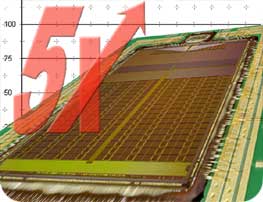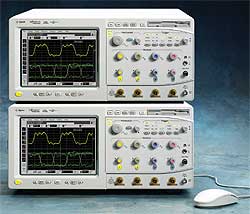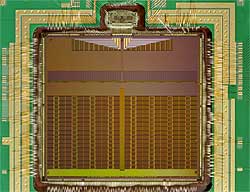Faster Than You Can Say A-to-D
|
|
February 10 , 2003
Innovation-focused design team at Agilent Labs creates the world's fastest A-to-D converter for Agilent's latest high-performance Infiniium oscilloscopes - and helps high-tech designers rest easier Designers at computer, semiconductor and communications companies don't make small mistakes. One undetected flaw in their circuit board or chip and millions of dollars are wasted in a matter of hours. Neither can they take their sweet time. One day's delay -- or even one hour's delay -- and millions more dollars slip away. Knowing this, it's no wonder Ken Poulton and his design team at Agilent Laboratories were excited when they first presented their idea to dramatically enhance performance for a new high-end digital oscilloscope -- the very tool designers count on to detect those potentially costly flaws and avoid delays. The new analog-to-digital (A-to-D) converter, which promised at least a five-fold improvement in system bandwidth and sample rate, would be the critical component in Agilent's new oscilloscope product.
"Agilent's test-and-measurement division was a little skeptical at first," says Poulton. "There were an awful lot of new elements that required meticulous, never-been-done-before solutions. This just multiplied the number of things that could go wrong. But we knew we had the right idea. And that meant we were going to make a lot of digital system designers very happy." The end result of Agilent Labs' innovation can be found in Agilent's new family of 4- to 6-GHz bandwidth Infiniium oscilloscopes, the only models in the industry that offer four full-bandwidth channels at a speedy 20 gigasamples per second (GSa/s) on each channel. These high-end systems are essential to research and development engineers in the computer, communications, and semiconductor industries for validating and verifying the performance of new high-speed digital product designs. World's Fastest A-to-D Converter
Unlike competing A-to-D converters using the fastest semiconductor process possible, the Agilent team inventively employed mainstream digital CMOS, which substantially reduced manufacturing costs and system power consumption. In effect, the Agilent Labs' team built the world's fastest A-to-D converter using relatively slow transistors, albeit in innovative ways. But to make this significant contribution, and to do so in a timely manner, the development teams would take yet another risk. Instead of Agilent Labs taking its traditional role of developing key technologies in advance of product design work, it did something it rarely does: put itself in the critical design path for the overall project. That meant the division's product schedule would be tied directly to development work coming out of Agilent Labs. It also meant a dramatic change in how the project would be managed and added complexity to coordinating development schedules between the two design teams. And for both teams, this changed everything. "The A-to-D converter was an essential part to our scope design," says Mike Karin, an R&D manager for Agilent's high-end oscilloscopes. "So we adopted a strong culture of risk management to keep that piece of technology on the critical path even though it put the Labs' guys in an unfamiliar position." Technical Hurdles
For example, the latest design combines 80 A-to-D converters, all time-interleaved on a single chip. The team's previous design combined a mere 32 converters. By comparison, no other gigasample ADC design has used more than six. Says Agilent Labs' Design Engineer Robert Neff: "We took the extreme technique used in our previous-generation A-to-D converter and took it to even greater extremes." While this dramatically improves sample rate by sharing the load across 80 converters, it requires the difficult technological feat of precise picosecond (one trillionth of a second) timing within the device. But adding more converters also had the undesirable effect of reducing bandwidth. To counter this, an input-buffer chip was added to increase bandwidth to six times greater than in the previous CMOS A-to-D converter design. And while this was accomplished using the more expensive silicon germanium (SiGe) semiconductor process, the cost impact of this small chip to the overall package was minimal. Another significant challenge for the Agilent Labs' team included redesigning the new chip so that it used only half the supply voltage of the previous design -- down to 1.6 volts from 3.3 volts. This enabled the team to embed system memory on the chip and improve performance. For their work on A-to-D converters, Poulton and Neff were honored with the Barney Oliver Prize, Agilent Labs' annual award for technical contributions that demonstrate a level of creativity, innovation, technical depth, or business value that stands out from the norm, and leads to a useful technical or scientific result. Worth the Risk "I'm very proud of this," says Karin. "With the combined effort from the design team at Labs and the design team here, we pulled off something rather remarkable." Related Information |


